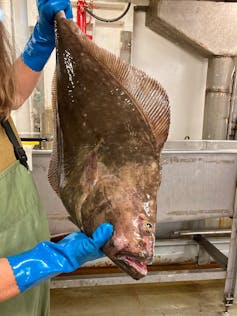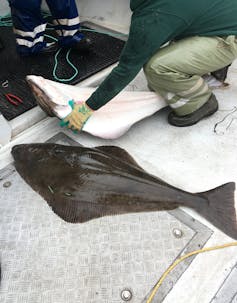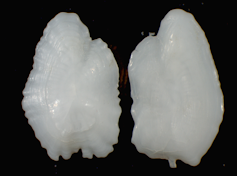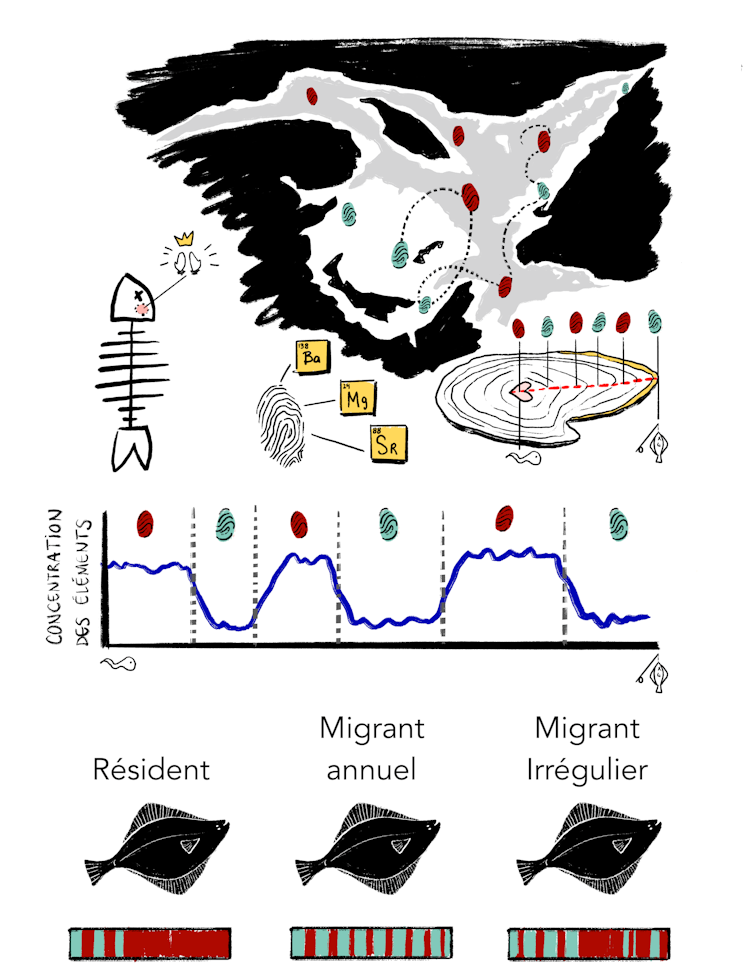Rising temperatures, changes in major currents, oxygen depletion at great depths: the Gulf of St. Lawrence has undergone major changes in its environmental conditions in recent decades. That has put many species in danger and, as a consequence, made them more sensitive to the effects of fishing.
However, these changes are benefiting other species such as Atlantic halibut, which is beating records for its abundance and is presently seeing the highest stock in the Gulf of St. Lawrence in the last 60 years.
As a biology researcher, I’d like to shed some light on some of the mysteries that still surround this unusual species.
This article is part of our series, The St. Lawrence River: In depth.
Don’t miss new articles on this mythical river of remarkable beauty. Our experts look at its fauna, flora and history, and the issues it faces. This series is brought to you by La Conversation.
Atlantic halibut: champion of the Gulf of St. Lawrence
Atlantic halibut is a flatfish that lives at the bottom of the estuary and gulf of the St. Lawrence. It is prized for its fine, firm white flesh, which is highly appreciated by consumers.

(Charlotte Gauthier), Provided by the author
Halibut can grow to impressive sizes of more than two metres. Because of the quality of its flesh and its popularity on dinner plates, it is currently the most commercially valuable fish in the Gulf of St. Lawrence.
But this has not always been the case. In the 1950s, the adult, harvestable portion of halibut populations, known as the stock, suffered a major decline due to overfishing.

(Charlotte Gauthier), Provided by the author
If we want to continue to exploit this resource over the long term, we must not repeat the same mistakes we made in the past. To avoid these mistakes, it is vital to have a good understanding of the life cycle of halibut and the effects that fishing can have on the stock. So far, this has not been done to the fullest.
The challenges for sustainable fishing
The basic biology of Atlantic halibut is fairly well known. However, both the habitats they use throughout their lives and their movement between these places are more difficult to characterize.
Recent studies have placed satellite tags on halibut to record data on the depth and temperature of the water in which they are found, making it possible to accurately calculate their movement. By using this method, the researchers were able to identify the trajectories of adult halibut over a one-year period and discover that they reproduce in winter in the deep channels of the Gulf.
In the halibut’s different annual trajectories, the researchers observed that, in summer, some remain in the deep channels while others migrate to shallower areas.
Even with this new information, a number of questions remain, specifically about the youngest life stages, which are caught only anecdotally in the Gulf. Satellite tags also provide accurate information, but only over a one-year period, which doesn’t tell the whole story for a fish that can live up to 50 years.
With this in mind, the use of a new tool to study the entire life of fish becomes highly relevant.
Ear bones to the rescue
All bony fish have small calcareous structures in their inner ear called otoliths, or ear bones, which perform balance and hearing functions.

(Charlotte Gauthier), Provided by the author
Otoliths develop at the very beginning of a fish’s life and grow at the same rate as the fish. Otoliths form annual growth rings that are comparable to those visible in tree trunks.
To grow, otoliths accumulate chemical elements that are found in the environment in which the fish swim. So, when the fish moves, the chemical elements accumulated in the otoliths will be different from one place to another. Each location is characterized by a unique combination of different concentrations of chemical elements. This is known as an elemental fingerprint. Identifying these fingerprints can provide us with crucial information about the movement of fish in different places throughout their lives.
I used this method of characterizing the chemical elements in otoliths to study the migratory patterns of Atlantic halibut in the Gulf of St. Lawrence.
A wide range of migratory strategies
To find out what concentrations of a chemical element correspond to the place where the fish was caught, we use the fingerprint of the otolith margin, i.e. the material at the end of the outermost ring of the otolith, which was accumulated last.
The concentrations of the elements found there are considered to be characteristic of the place where the fish was caught. By analyzing the margins of nearly 200 halibut otoliths from all over the Gulf, I was able to distinguish two basic fingerprints: one representative of surface waters (less than 100 metres deep) and one characteristic of deeper waters (more than 100 metres deep).
Once these fingerprints had been identified, I observed the concentration of chemical elements throughout the life of the fish so that I could associate each moment of life with either the surface water fingerprint or the deep-water fingerprint.
By separating the life of each individual into time spent in surface and deep waters, I was able to identify recurring patterns and group them into three different migratory strategies: residents, annual migrants and irregular migrants.
In this way, I was able to observe that halibut caught in the southern part of the Gulf were mainly annual migrants, and therefore undertake migrations between deep and shallow waters every year. However, in the northern part of the Gulf the majority are residents. Residents are fish that may have migrated early in their lives, but have settled permanently in deep waters before reaching maturity. Irregular migrants, on the other hand, show migrations on a more sporadic frequency, and are found in similar proportions throughout the study area.

(Charlotte Gauthier), Provided by the author
On the right track to optimal management
My study is the first to offer a global view of the movements made by halibut over their entire lifetime.
This new information provides a better understanding of the structure of the stock and the diversity of migratory strategies that can be found within it.
Given that these strategies are distributed differently in different areas of the Gulf, we can ensure that we do not disproportionately target halibut using the same migratory strategy and avoid overfishing a single component of the stock.
In this way, it is possible to conserve this diversity, which helps the stock’s resilience in the face of the various changes that can occur.




